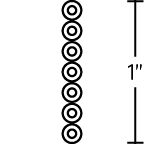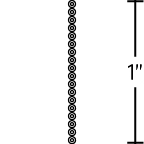When choosing machine knit work gloves, you’ve probably noticed that most descriptions include the glove’s gauge. The gauge of a glove is defined as the number of stitches included in each inch of material. Manufacturers typically offer gloves that range from 7-gauge to 18-gauge. This is the thickness of the knitted fabrics used in manufacturing. You might think that lower equals lighter and that higher equals heavier – but actually the opposite is true! Lower gauge gloves are heavier and higher gauge gloves are lighter.
 A lower-gauge glove uses thicker yarn and has fewer stiches knitted per inch. This creates a looser knit with more room between the stitches.
A lower-gauge glove uses thicker yarn and has fewer stiches knitted per inch. This creates a looser knit with more room between the stitches.
 A higher-gauge glove uses thinner, finer yarn and has more stitches knitted per inch. This creates a tighter knit. At the higher end, any room between stitches is invisible to the naked eye.
A higher-gauge glove uses thinner, finer yarn and has more stitches knitted per inch. This creates a tighter knit. At the higher end, any room between stitches is invisible to the naked eye.
Gauge 5
- Very thick knitted gloves
- Very thick threads
- High numbering (3000 to 6000 denier)
- Gloves knitted more loosely with a larger needle size
- There are no coated versions.
- Perfect for heavy duty work combined with special threads.
Gauge 7
- Thick knitted gloves
- Thick threads
- High numbering (1500 to 3000 denier)
- Can be braided
- Looser-knitted gloves
- Looped fabric machines available in gauge 7
- Very few coated versions.
- Combinations of polyester and cotton, cotton or polyester with or without stitching are usual for general applications.
Gauge 10
- Medium thickness knitted gloves
- Threads are not as thick as for gauge 7
- Low numbering (700 to 1300 denier)
- Medium weight gloves
- Tighter knitted gloves
- Can be braided
- Looped fabric machines also available in gauge 10
- Popular versions of the latex glove with a rough finish and the winter glove using looped fabric.
Gauge 13
- Fine knitted gloves
- Fine threads
- Relatively low numbering (400 to 800 denier)
- Light gloves
- Tightly knitted gloves
- Difficult to braid
- The best known stitch today for polyurethane (PU) and nitrile gloves
- More profitable and cheaper than other lighter versions.
Gauge 15
- Fine knitted gloves
- Relatively low numbering (140 to 400 denier)
- Light gloves (until 2011, the lightest on the market with the most developed fabric at the time)
- Tightly knitted gloves
- Difficult to braid
- Ideal for light work
Gauge 18
- Very fine knitted gloves
- Current standard of ultralight protection
- Only available from some manufacturers
- Very fine threads
- Very low numbering (100 to 200 denier)
- Particularly light gloves
- Soft, flexible gloves
- Extremely difficult to braid
 A lower-gauge glove uses thicker yarn and has fewer stiches knitted per inch. This creates a looser knit with more room between the stitches.
A lower-gauge glove uses thicker yarn and has fewer stiches knitted per inch. This creates a looser knit with more room between the stitches. A higher-gauge glove uses thinner, finer yarn and has more stitches knitted per inch. This creates a tighter knit. At the higher end, any room between stitches is invisible to the naked eye.
A higher-gauge glove uses thinner, finer yarn and has more stitches knitted per inch. This creates a tighter knit. At the higher end, any room between stitches is invisible to the naked eye.